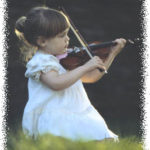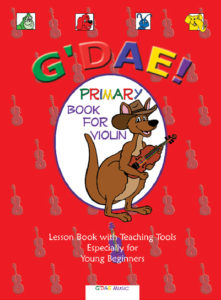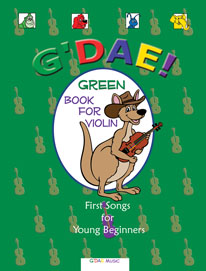Teaching Violin with G’DAE™ Color Coding
 Our Philosophy: To Read or Not To Read (Music, that is)?
Our Philosophy: To Read or Not To Read (Music, that is)?
Children can begin to play a musical instrument like the violin or piano before they enter school. But soon, playing an instrument also requires a new mental skill: learning to read music. Some early-childhood music teaching methods (like the Suzuki Method) put off this challenge by first teaching students to play by ear. Many students taught exclusively by ear become so good at playing this way that they find it hard to learn to read music later. Consequently, they face a handicap when they want to join a school or youth orchestra with students who started learning the instrument later, in a class setting.
Begin with Color
 Preschoolers and kindergarteners are learning how symbols communicate meanings. They are starting to decode symbols from left to right. But 4 to 7 year olds usually already know their primary colors, numbers at least up to 5, and alphabet letters at least as far as G. Colors, numbers and letters are where G’DAE!™ lessons begin, and building the treble clef staff is where they lead.
Preschoolers and kindergarteners are learning how symbols communicate meanings. They are starting to decode symbols from left to right. But 4 to 7 year olds usually already know their primary colors, numbers at least up to 5, and alphabet letters at least as far as G. Colors, numbers and letters are where G’DAE!™ lessons begin, and building the treble clef staff is where they lead.
In Europe, young children have been taught to read music using color-coding since the 1970s. Colors relate the notes of familiar songs to their location on the stringed instrument and also to symbols on the printed page. This method is not available or even known in the U.S., possibly because it does not start with music familiar to North American preschoolers, and because of the overwhelming popularity of Suzuki teaching for this age group.
A Bridge to Music Reading
G’DAE!™ lesson materials are designed with pre-readers in mind! Adapting this proven teaching method for young violin students, G’DAE!™ beginners’ lesson materials create a bridge to music reading for pre-readers and early readers. G’DAE!™ materials associate colors, names and animal characters with each string on the violin. Simple, familiar tunes are printed with colored notes and finger numbers taking the place of the musical staff. Students learn the rhythmic meanings of different note shapes, by using colorful flashcards, games and exercises. Gradually, the notes are moved onto the staff, which is also color-coded at first, and finger numbers are removed.
As the student starts to understand how to identify notes by their position on the staff, they are ready to graduate to an elementary-level violin method book.

Developed for teachers, by a teacher
In 2005, a nationally certified violin teacher went on a quest to find kid-friendly teaching materials for her own daughter. She was trying to find a method that emphasized music-reading from the very beginning. Unable to find such a teaching method available commercially, she drew on her design and communications background to develop materials to use in her own studio, and then began sharing them with others. This is how G’DAE Music began.
G’DAE!™ lessons and games are designed for experienced teachers to introduce the violin and music-reading to young students. They help young violinists get started via a fun, visually stimulating and effective means of learning. The lesson materials also guide parental assistance during practice sessions. In lessons, the teacher will still need to go “off the page” to show the physical handling of the violin and bow, proper posture, intonation etc. Younger students may need several weeks to cover one “lesson.” Older students may progress more quickly. Students should review frequently, to continue to build their understanding of the concepts presented in the lessons, games and flashcards.
Adaptable and Expandable
With the color-coding materials provided, teachers can adapt other beginner lesson materials to this method after the basic concepts are understood. Teachers can supplement these materials with illustrations, exercises and songs they have developed.
Lessons in the Primary Book for Violin include:
- The violin, its parts, the left hand and its finger numbers, the colors and animal names of the strings; rhythm of quarter notes and two-eighth pairs, the quarter-rest, holding and moving the bow up and down and side to side.
- Plucking quarter-notes with quarter-rests on each open string; reinforcing string-color identification.
- Making different rhythm patterns with quarters and two-eighths (“Make A Rhythm” Game); the 4-beat measure; plucking rhythm patterns and beginning bowing.
- Open-string, 2nd-finger note combinations; directed repetition and counting skills.
- Open, First and Second-finger songs; half notes; introducing simplified staff lines and bar lines, and following finger-numbered notes.
- More 0-1-2 songs on one string; tracking left-to-right notation; sing-clap-and-play
- Function of the music staff lines and spaces (“Bird on a Wire” Game); simplified staff for each string by color. Adding 3rd finger; 3-beat measures; dotted half note.
- Bow control and whole notes; ascending and descending fingers on strings.
- 0-1-2-3 fingers and one string crossing. Rhythmic bowing; extended song (“Twinkle, Twinkle”).
- The Music Alphabet; complete (color-coded) treble-clef staff and note-name identification; finding notes on the string by staff-position, not finger-numbers (Music Note House Game/worksheet).
- Introducing dynamics, more music-reading without finger-numbers. Note Concentration flashcard game. Dotted-quarter with eighth-note combination rhythm.
- Playing scales beginning on each open string. Reading notation of scales on colored staff, from lowest to highest first-position notes. Wrap-up review game (Joey’s Boomer Bingo).
Method Book Transition
 Ideas for bridging G’DAE!™ concepts over to black-and-white elementary lesson materials are included in the introductory Parent/Teacher Guide in each Primary Book.
Ideas for bridging G’DAE!™ concepts over to black-and-white elementary lesson materials are included in the introductory Parent/Teacher Guide in each Primary Book.
A companion book, “First Songs for Young Beginners“, contains more tunes and songs to add to the Primary Book lesson materials.
